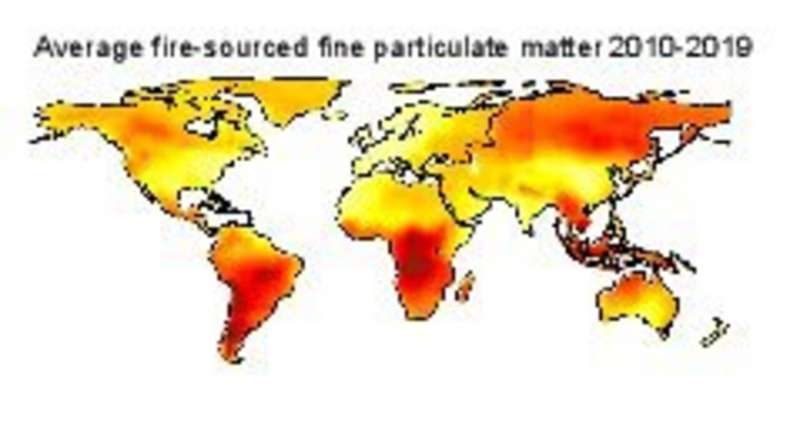This article has been reviewed according to Science X's editorial process and policies. Editors have highlighted the following attributes while ensuring the content's credibility:
fact-checked
peer-reviewed publication
trusted source
proofread
Alarming results from world-first study of two decades of global smoke pollution

The world's first study of the increase in pollution from landscape fires across the globe over the past two decades reveals that more than 2 billion people are exposed to at least one day of potentially health-impacting environmental hazard annually—a figure that has increased by 6.8% in the last 10 years.
The study highlights the severity and scale of the landscape fire-sourced air pollution, its increased impact on the world's population and associated rise in public health risk. Exposure to fire-sourced air pollution has many adverse health impacts, including increased mortality and morbidity and a global worsening of cardiorespiratory conditions and mental health.
The study, published today (20 September) in Nature and led by Australian scientists, estimated the global daily air pollution from all fires from 2000 to 2019. The researchers found that 2.18 billion people were exposed to at least one day of substantial landscape fire air pollution in each year, with each person in the world having on average 9.9 days of exposure per year, an increase of 2.1% in the last decade. It also found that exposure levels in low-income countries were about four-fold higher than in high income countries.
Led by Professors Yuming Guo and Shanshan Li, from Monash University's School of Population Health and Preventive Medicine, the study also found that the exposure levels of PM2.5 were particularly high in Central Africa, Southeast Asia, South America and Siberia. The study also looked at global landscape fire-sourced ozone, an important fire-related pollutant has only been estimated for United States.

In the study, landscape fires refer to any fires burning in natural and cultural landscapes, e.g., natural and planted forest, shrub, grass, pastures, agricultural lands and peri-urban areas, including both planned or controlled fires (e.g., prescribed burns, agricultural fires) and wildfires (defined as uncontrolled or unplanned fires burning in wildland vegetation).
The comprehensive assessment of the global population exposures to fire-sourced PM2.5 and ozone during 2000–2019 was calculated using a machine learning approach with inputs from chemical transport models, ground-based monitoring stations, and gridded weather data.
The recent pollution from the Canadian wildfires that spread smoke across North America highlighted the increase in severity and frequency of landscape fires due to climate change. According to Professor Guo, no study to date has looked at the long-range effect of this increase in landscape fires globally and wildfires often impact remote areas where there are few or no air quality monitoring stations. In addition, in many low-income countries, there are no air quality monitoring stations even in urban areas.

"The exposure to air pollution caused by landscape fire smoke traveling hundreds and sometimes even thousands of kilometers can affect much larger populations, and cause much larger public health risks," he said.
"Mapping and tracking the population exposure to landscape fire-sourced air pollution are essential for monitoring and managing its health impacts, implementing targeted prevention and interventions, and strengthening arguments for mitigation of climate change."
More information: Xu Yue, Global population exposure to landscape fire air pollution from 2000 to 2019, Nature (2023). DOI: 10.1038/s41586-023-06398-6. www.nature.com/articles/s41586-023-06398-6
Journal information: Nature
Provided by Monash University




















